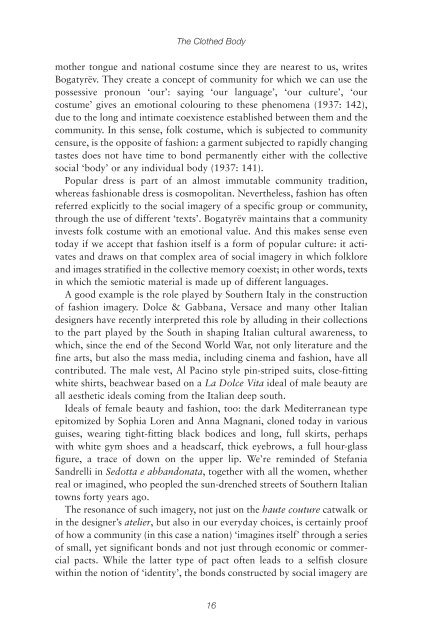You also want an ePaper? Increase the reach of your titles
YUMPU automatically turns print PDFs into web optimized ePapers that Google loves.
<strong>The</strong> <strong>Clothed</strong> <strong>Body</strong><br />
mother tongue and national costume since they are nearest to us, writes<br />
Bogatyrëv. <strong>The</strong>y create a concept of community for which we can use the<br />
possessive pronoun ‘our’: saying ‘our language’, ‘our culture’, ‘our<br />
costume’ gives an emotional colouring to these phenomena (1937: 142),<br />
due to the long and intimate coexistence established between them and the<br />
community. In this sense, folk costume, which is subjected to community<br />
censure, is the opposite of fashion: a garment subjected to rapidly changing<br />
tastes does not have time to bond permanently either with the collective<br />
social ‘body’ or any individual body (1937: 141).<br />
Popular dress is part of an almost immutable community tradition,<br />
whereas fashionable dress is cosmopolitan. Nevertheless, fashion has often<br />
referred explicitly to the social imagery of a specific group or community,<br />
through the use of different ‘texts’. Bogatyrëv maintains that a community<br />
invests folk costume with an emotional value. And this makes sense even<br />
today if we accept that fashion itself is a form of popular culture: it activates<br />
and draws on that complex area of social imagery in which folklore<br />
and images stratified in the collective memory coexist; in other words, texts<br />
in which the semiotic material is made up of different languages.<br />
A good example is the role played by Southern Italy in the construction<br />
of fashion imagery. Dolce & Gabbana, Versace and many other Italian<br />
designers have recently interpreted this role by alluding in their collections<br />
to the part played by the South in shaping Italian cultural awareness, to<br />
which, since the end of the Second World War, not only literature and the<br />
fine arts, but also the mass media, including cinema and fashion, have all<br />
contributed. <strong>The</strong> male vest, Al Pacino style pin-striped suits, close-fitting<br />
white shirts, beachwear based on a La Dolce Vita ideal of male beauty are<br />
all aesthetic ideals coming from the Italian deep south.<br />
Ideals of female beauty and fashion, too: the dark Mediterranean type<br />
epitomized by Sophia Loren and Anna Magnani, cloned today in various<br />
guises, wearing tight-fitting black bodices and long, full skirts, perhaps<br />
with white gym shoes and a headscarf, thick eyebrows, a full hour-glass<br />
figure, a trace of down on the upper lip. We’re reminded of Stefania<br />
Sandrelli in Sedotta e abbandonata, together with all the women, whether<br />
real or imagined, who peopled the sun-drenched streets of Southern Italian<br />
towns forty years ago.<br />
<strong>The</strong> resonance of such imagery, not just on the haute couture catwalk or<br />
in the designer’s atelier, but also in our everyday choices, is certainly proof<br />
of how a community (in this case a nation) ‘imagines itself’ through a series<br />
of small, yet significant bonds and not just through economic or commercial<br />
pacts. While the latter type of pact often leads to a selfish closure<br />
within the notion of ‘identity’, the bonds constructed by social imagery are<br />
16

















